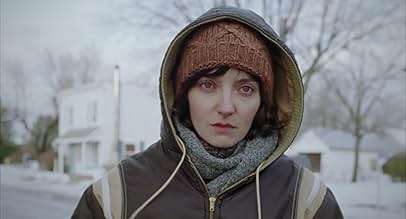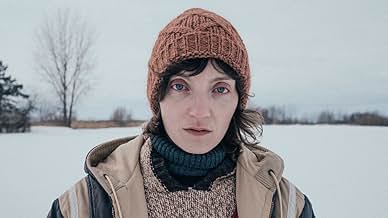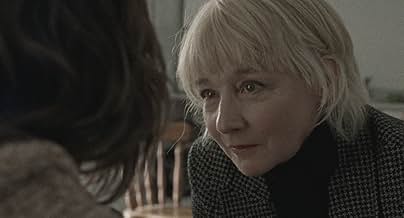IMDb RATING
6.3/10
1.5K
YOUR RATING
In a small and isolated town, Simon Dubé dies in a car accident. The stunned townspeople are reluctant to discuss the circumstances of the tragedy. From that point on time seems to lose all ... Read allIn a small and isolated town, Simon Dubé dies in a car accident. The stunned townspeople are reluctant to discuss the circumstances of the tragedy. From that point on time seems to lose all meaning, and the days stretch on without end.In a small and isolated town, Simon Dubé dies in a car accident. The stunned townspeople are reluctant to discuss the circumstances of the tragedy. From that point on time seems to lose all meaning, and the days stretch on without end.
- Director
- Writers
- Stars
- Awards
- 3 wins & 21 nominations total
- Director
- Writers
- All cast & crew
- Production, box office & more at IMDbPro
Featured reviews
I think somebody forgot to create a conflict or subject in the plot.. i didnt enjoy except baloon girl... MUBI keep the money but give my precious time back that i lost for this movie at least 40 percent of it
Saw this at the Berlinale 2019, where it was part of the official Competition (but got no prize). Peculiarly, the venue was only half full, contrary to all other screenings in foregoing days in the Berlinale Competition with usually 1,750 viewers present in the same venue. I assume that many people thought this movie had all appearances of a downtrodder path Horror movie with zombies. That genre left traces by everyone, caused by bad B-movies we all sat through in the past but avoid them nowadays. However, this movie does not have any of the negative characteristics of said genre with a bad reputation. It is true that strange figures appear when the story progresses, but they stand still, make no sound and do not attack. They just stare from a safe distance.
The fatal car accident in the opening scene could have been a suicide or a real accident. We saw it happen and we can't tell either way, and neither has the police any idea. The dilemma casts a shadow over all daily tasks within the village. The uncertainty eats the villagers, and the topic returns several times in conversations. It is a closed community of 200 to 300 people, committed to support each other, to the extent that outside help is flatly refused by the mayor.
At first, we see nothing out of the ordinary. But strange things start happening, albeit innocent and harmless. Gradually, it gets stranger and stranger. The first time that we come to think there is more to it than just strangers wandering around, is when a "social worker lady" is locked up after one of the unknown figures outside a derilicted building slams the door while she is inside. No harm gets to her, she easily escapes and reports the incident. Without any witnesses she meets nothing but disbelief. Probably a "weak nerves" case is a common conclusion.
When more and more strange figures appear, we become gradually aware that something is really going on. The figures do not harm anyone. They maintain a safe distance from the villagers, they just stand there and make no sound. Nevertheless, their mere presence feels threatening. It is no use to describe what happens next. Suffice to say that situation and atmosphere "got" me. It became more intense by the minute. I have no explanation why, and also no idea how the film makers achieved the effect it had. For me a unique experience, as most "horror" movies have no effect on me at all.
I must confess to be slightly put off at first, due to the festival announcement talking about the 16 mm format intended to strengthen the admosphere, and that traditional celluloid was used for similar reasons. This sounded like a typical case of format-over-substance. In other words, conversation pieces for professional critics and film makers, but shooting over the heads of layman viewers like myself. But I stand corrected and my prejudice proved false. Despite the format and the cellulloid, or maybe even thanks to this, the atmosphere took me in and kept me interested all the time.
All in all, an intriguing movie by effectively letting a tense atmosphere grow on me, something I felt deep inside. I wonder how the film makers did it.
The fatal car accident in the opening scene could have been a suicide or a real accident. We saw it happen and we can't tell either way, and neither has the police any idea. The dilemma casts a shadow over all daily tasks within the village. The uncertainty eats the villagers, and the topic returns several times in conversations. It is a closed community of 200 to 300 people, committed to support each other, to the extent that outside help is flatly refused by the mayor.
At first, we see nothing out of the ordinary. But strange things start happening, albeit innocent and harmless. Gradually, it gets stranger and stranger. The first time that we come to think there is more to it than just strangers wandering around, is when a "social worker lady" is locked up after one of the unknown figures outside a derilicted building slams the door while she is inside. No harm gets to her, she easily escapes and reports the incident. Without any witnesses she meets nothing but disbelief. Probably a "weak nerves" case is a common conclusion.
When more and more strange figures appear, we become gradually aware that something is really going on. The figures do not harm anyone. They maintain a safe distance from the villagers, they just stand there and make no sound. Nevertheless, their mere presence feels threatening. It is no use to describe what happens next. Suffice to say that situation and atmosphere "got" me. It became more intense by the minute. I have no explanation why, and also no idea how the film makers achieved the effect it had. For me a unique experience, as most "horror" movies have no effect on me at all.
I must confess to be slightly put off at first, due to the festival announcement talking about the 16 mm format intended to strengthen the admosphere, and that traditional celluloid was used for similar reasons. This sounded like a typical case of format-over-substance. In other words, conversation pieces for professional critics and film makers, but shooting over the heads of layman viewers like myself. But I stand corrected and my prejudice proved false. Despite the format and the cellulloid, or maybe even thanks to this, the atmosphere took me in and kept me interested all the time.
All in all, an intriguing movie by effectively letting a tense atmosphere grow on me, something I felt deep inside. I wonder how the film makers did it.
Do you believe in ghosts? Do you believe in other dimensions? Do you believe in reincarnation? Ghost Town Anthology is a film that brings questions like this to the forefront of your consciousness. The film opens with a frigidly framed car crash, that appears to happen out of nowhere, finding a way to sneak between sounds of the wind blowing and the trees creaking. The driver of the car was Simon Dube played by Phillipe Charette, leaving behind his distraught parents Romuald played endearingly by Jean-Michel Anctil and Gisele played by Josée Deschênes. His older brother Jimmy played with skill by Robert Naylor picks the film up from his brother's death, beginning a search for his brother because in his mind he could not have just left him like that even though the audience can see that Jimmy knows the true cause of his brother's death and it was not accidental, making Jimmy's search for signs of his brother all the more heart wrenching. The father, Romuald, tells his wife Giselle he is going to buy cigarettes, ultimately leaving a note explaining that he needs time and space to mourn the death of his son. Personally the scenes that followed of the father Romuald and his grieving process were some of my favorite moments of the film and the director makes no attempt at making it clear if the father is ever going to actually return.
The director of Ghost Town Anthology, Dennis Cote has quite a vision and understanding of spiritual imagery and feeling, the sound design is something that is so unique and unnervingly special. The brilliance of it is chiefly noticeable in the fathers grieving scenes. Cote masks bleak desolate moving landscapes shot as if the camera has been mounted in a 1987 pickup truck, with sounds of wind, static, and crackling; the only difference being in the patterns the sounds play in is completely different from anything I have heard before. The film was shot in 16mm and in these brief moments the 16mm film looks much closer to 8mm film, clearly having been scratched and tampered with by the creators of the film and then developed in black and white to add to the lo-fi feelings being heavily transmitted through the film. The camera movements in these very vague almost elusive scenes is all the more interesting, if it doesn't feel like it's been mounted to a pickup truck, it feels as if it's been mounted to a wounded animal walking its way to its demise, trudging along the bare landscape.
The death of the boy sends shockwaves through the small town, ultimately becoming the sole focus of the town's mayor Simone Smallwood, played by Diane Lavallée, who appears to have one sole mission in life and that is to ensure that her town carries on its daily life, every day, with no change or help from outsiders. As a reaction to the boy's death, a political official known to Smallwood sends a psychiatrist from the "big city" to assist with the psychological effects of the boy's death in the town. The new face is quickly dismissed by the mayor who claims that the towns people is made up of "grown ups" and they can "handle themselves", leaving the story to the isolation of the few faces the audience has seen. One of the faces that is most intriguing is a woman named Adele, played by Larissa Corriveau. Adele is the type of character whom simply steals the camera because she has a look that is so unusual and uncanny. Her character is a supposed newcomer to the town, making it all the more interesting due to her severe social anxiety. Dennis Cote captures how one feels when they have social anxiety with swift minimalism, particularly in a scene early on in the film where he utilizes a tracking shot. The camera tracks Adele from the washroom of a New Year's Eve party, in the middle of a pep talk nonetheless, all the way through the party until she encounters Jimmy and his best friend Andre. The way Larissa Corriveau walks through the party, making sure to never once look in place, avoiding physical contact and eye contact is beyond an accurate depiction of social anxiety and she hits her marks perfectly. The dialogue between Adele, Jimmy and Andre is innocent and naturally dry, a true contender for the most cringe worthy moment in cinema this year.
As strange people begin to arrive in the town including Jimmy having an encounter with his recently deceased brother with no explanation and more and more of the townspeople beginning to see the people themselves the film shifts its gears to more serious questions. There are multiple scenes with supremely high tension in the gradual revealing of these strange arrivals to the town. The town's people begin to almost show frustration to their attendance, not because they are ghosts but because it further punctuates their isolation by having these people show up. What more of a reason to move to the big city than having the dead walk your neighbourhood, right? This commentary of life and death, and exposure versus isolation become very focal themes in the film and it makes for truly different cinema.
Overall the film is quite good, although at times disorganized and scattered with the plot and character development. Dennis Cote has made primarily documentaries and experimental films, having Ghost Town Anthology be considered as his first official feature film. The application of 16mm film and shaky cam prove effective in not only the setting and story but mesh perfectly with Cote's eye and style. The film feels as if it is a short film that has been extended and obviously this can be attributed to Cote's former projects. It would be interesting to see him apply his eye for human nature and psychology to something slightly less experimental. In the end Ghost Town Anthology raises lots of questions about life, death, reincarnation and having enough time, and it is a quality contribution to the supernatural genre.
The director of Ghost Town Anthology, Dennis Cote has quite a vision and understanding of spiritual imagery and feeling, the sound design is something that is so unique and unnervingly special. The brilliance of it is chiefly noticeable in the fathers grieving scenes. Cote masks bleak desolate moving landscapes shot as if the camera has been mounted in a 1987 pickup truck, with sounds of wind, static, and crackling; the only difference being in the patterns the sounds play in is completely different from anything I have heard before. The film was shot in 16mm and in these brief moments the 16mm film looks much closer to 8mm film, clearly having been scratched and tampered with by the creators of the film and then developed in black and white to add to the lo-fi feelings being heavily transmitted through the film. The camera movements in these very vague almost elusive scenes is all the more interesting, if it doesn't feel like it's been mounted to a pickup truck, it feels as if it's been mounted to a wounded animal walking its way to its demise, trudging along the bare landscape.
The death of the boy sends shockwaves through the small town, ultimately becoming the sole focus of the town's mayor Simone Smallwood, played by Diane Lavallée, who appears to have one sole mission in life and that is to ensure that her town carries on its daily life, every day, with no change or help from outsiders. As a reaction to the boy's death, a political official known to Smallwood sends a psychiatrist from the "big city" to assist with the psychological effects of the boy's death in the town. The new face is quickly dismissed by the mayor who claims that the towns people is made up of "grown ups" and they can "handle themselves", leaving the story to the isolation of the few faces the audience has seen. One of the faces that is most intriguing is a woman named Adele, played by Larissa Corriveau. Adele is the type of character whom simply steals the camera because she has a look that is so unusual and uncanny. Her character is a supposed newcomer to the town, making it all the more interesting due to her severe social anxiety. Dennis Cote captures how one feels when they have social anxiety with swift minimalism, particularly in a scene early on in the film where he utilizes a tracking shot. The camera tracks Adele from the washroom of a New Year's Eve party, in the middle of a pep talk nonetheless, all the way through the party until she encounters Jimmy and his best friend Andre. The way Larissa Corriveau walks through the party, making sure to never once look in place, avoiding physical contact and eye contact is beyond an accurate depiction of social anxiety and she hits her marks perfectly. The dialogue between Adele, Jimmy and Andre is innocent and naturally dry, a true contender for the most cringe worthy moment in cinema this year.
As strange people begin to arrive in the town including Jimmy having an encounter with his recently deceased brother with no explanation and more and more of the townspeople beginning to see the people themselves the film shifts its gears to more serious questions. There are multiple scenes with supremely high tension in the gradual revealing of these strange arrivals to the town. The town's people begin to almost show frustration to their attendance, not because they are ghosts but because it further punctuates their isolation by having these people show up. What more of a reason to move to the big city than having the dead walk your neighbourhood, right? This commentary of life and death, and exposure versus isolation become very focal themes in the film and it makes for truly different cinema.
Overall the film is quite good, although at times disorganized and scattered with the plot and character development. Dennis Cote has made primarily documentaries and experimental films, having Ghost Town Anthology be considered as his first official feature film. The application of 16mm film and shaky cam prove effective in not only the setting and story but mesh perfectly with Cote's eye and style. The film feels as if it is a short film that has been extended and obviously this can be attributed to Cote's former projects. It would be interesting to see him apply his eye for human nature and psychology to something slightly less experimental. In the end Ghost Town Anthology raises lots of questions about life, death, reincarnation and having enough time, and it is a quality contribution to the supernatural genre.
I do not believe in Ghosts. But it is nice to see and read Ghost stories. But not many ghost stories are gripping these days. There is no emotional connection with the story or characters.
So nowadays it is a pleasant surprise when we come across an eerie ghost movie. Répertoire des villes disparues is such a story by Director Denis Cote.
It is a story about a small Quebec village where there are hardly 215 people staying. One day an accident takes place and a young boy of the village dies. This incident causes a small stir within the community - who commemorate the funeral of the boy, following up with a small get-together.
No one believes the boy Simon could have been so reckless in driving. There are speculation about the Simon's death - whether it was a suicide or is he still alive?
The brother, and parents await the return of Simon. The Mayor denies psychological support offered by The Federal Agency to villagers.
But within no time - people of the village discuss, feel and see things around the village that worries them.
By the end of the movie - people start leaving the village - thus the name - Ghosttown Anthology - how villages become Ghost Towns with houses but no people staying there.
As this is a village story - there is no central character who is the lead protagonist - but there are a few worth notable - The Mayor, the boy who died Simon, Simon's brother and parents, a man running a small roadside restaurant, a quirky lady who is on psychological treatment and is the first to see and experience ghostly things in her home and the village.
There are no regular cliches of ghost or horror story here which is FRESH- yet the proceedings are eerie.
Director Denis Cote has been successful in holding the narration tight.
I have seen two movies (Vic + Flo ont vu un ours and this one) of Denis Cote - and both these movies are totally different genres and he has handled them very well - I have started liking this Director Denis Cote and would like to see more of his movies in near future.
I would go with 7.5 out of 10 for this wonderful ghostly movie.
So nowadays it is a pleasant surprise when we come across an eerie ghost movie. Répertoire des villes disparues is such a story by Director Denis Cote.
It is a story about a small Quebec village where there are hardly 215 people staying. One day an accident takes place and a young boy of the village dies. This incident causes a small stir within the community - who commemorate the funeral of the boy, following up with a small get-together.
No one believes the boy Simon could have been so reckless in driving. There are speculation about the Simon's death - whether it was a suicide or is he still alive?
The brother, and parents await the return of Simon. The Mayor denies psychological support offered by The Federal Agency to villagers.
But within no time - people of the village discuss, feel and see things around the village that worries them.
By the end of the movie - people start leaving the village - thus the name - Ghosttown Anthology - how villages become Ghost Towns with houses but no people staying there.
As this is a village story - there is no central character who is the lead protagonist - but there are a few worth notable - The Mayor, the boy who died Simon, Simon's brother and parents, a man running a small roadside restaurant, a quirky lady who is on psychological treatment and is the first to see and experience ghostly things in her home and the village.
There are no regular cliches of ghost or horror story here which is FRESH- yet the proceedings are eerie.
Director Denis Cote has been successful in holding the narration tight.
I have seen two movies (Vic + Flo ont vu un ours and this one) of Denis Cote - and both these movies are totally different genres and he has handled them very well - I have started liking this Director Denis Cote and would like to see more of his movies in near future.
I would go with 7.5 out of 10 for this wonderful ghostly movie.
Its a horror without those ghost who have dirty fleshy skin who look like bunch of burned people this is a uniqe and simple horror movie , hence its beautiful
Did you know
- TriviaAdèle is the only character to wear colorful clothing.
- GoofsDuring the levitation scenes, the 'altitude' of Adèle in the sky changes from scene to scene.
- ConnectionsFeatured in 2020 Canadian Screen Awards for Cinematic Arts (2020)
Details
- Release date
- Country of origin
- Language
- Also known as
- Ghost Town Anthology
- Filming locations
- Saint-Michel, Québec, Canada(interior and exterior locations)
- Production company
- See more company credits at IMDbPro
- Runtime
- 1h 37m(97 min)
- Color
- Aspect ratio
- 1.85 : 1
Contribute to this page
Suggest an edit or add missing content






































